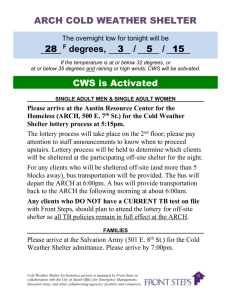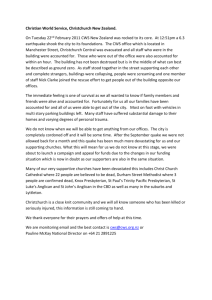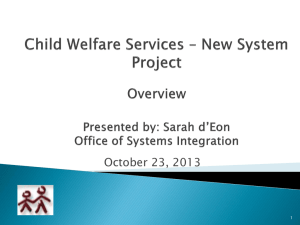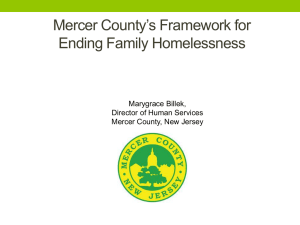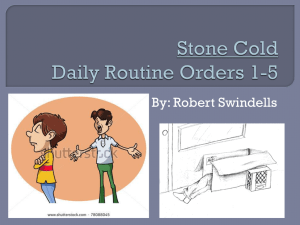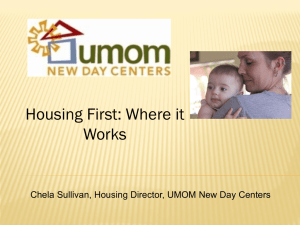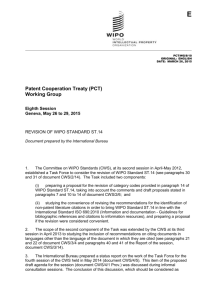Beyond Shelter Initiative Systemic Change in Clackamas County
advertisement
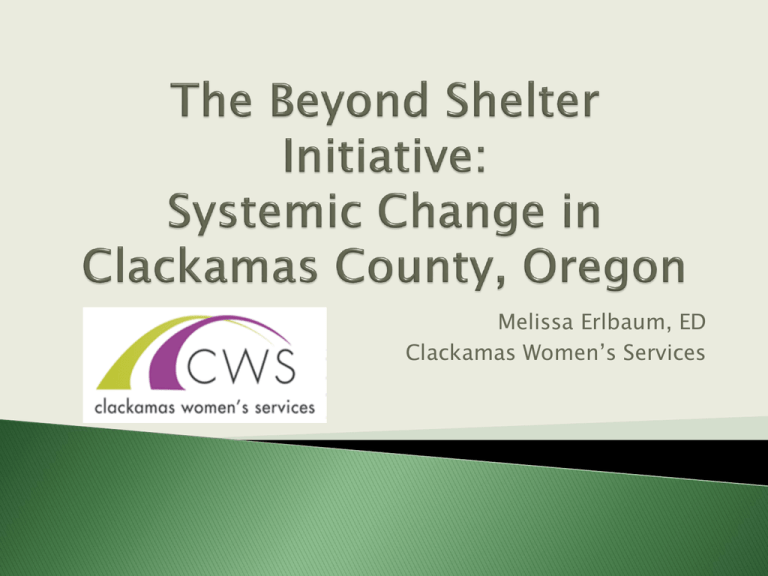
Melissa Erlbaum, ED Clackamas Women’s Services Geographic region (urban, suburban, rural) Few nonprofit agencies Long standing Community based grassroots Strong County government presence Large % of services delivered through the County system High value on long standing relationships Community ripe for collaboration Centralized intake system didn’t include all partners Prevention efforts weren’t streamlined and inadequate County’s homeless services/philosophy were deeply entrenched in the HUD COC system 10 year plan included vision for prevention • • • • • • • • • • • Homeless Service Providers Domestic Violence Provider Youth Services DHS Workforce development Clackamas County: Social Services & Community Development Rent Well Program (tenant education) Faith Based School Homeless Liaisons Special Needs Providers Housing Authority Benefits Experience with CCR Strong advocacy skills Expertise in safety planning and crisis intervention Experience with voluntary services models Access to different funding streams Understanding of trauma informed services Challenges HMIS Strict Confidentiality standards Less formal experience with homeless service system Historically focused on shelter as primary means for safety Resource competition • Understand mission, values and limitations about partner agencies • Determine timeline and meeting schedule • Build a conceptual program model • Aligning networks • Examine the diversity of perspectives Housing First Philosophy Address current gaps Joint resource acquisition Streamline access points Shared policies and procedures Comprehensive data collection Reporting/Evaluation Cultural competency Map out current system Document need Determine target population Create unified assessment Shared policies and procedures Determine short/long-term goals and measures (outputs, outcomes etc) In our community this took place over four months of bi-weekly meetings that followed an initial 4-5 meetings/trainings geared to get a “temperature read” of the propensity for change in the existing system. County’s Department of Health, Housing and Human Services contracts HPRP funds to CWS & NHA. CWS is the lead agency for 3 year United Way Systemic Change grant (contracts to the County’s Rent Well Program and NHA). CWS has Office on Violence Against Women Transitional Housing funding CWS & NHA have joint private foundation funding Culturally specific services – both partnership and inte Unified assessment tool Shared policy manual Engage in joint resource acquisition Cross training and joint training New prevention system has been created Streamlined process Effective use of resources Gained political will Housing Rights & Resources Line CWS 24-hour crisis line Referral to CWS or NHA for Assessment Action Plan Developed Diversion Prevention Housing Secured Established physical access points Data Collection -Centralized Services Shelter Housing search Stabilization – integration into community Clackamas Women’s Services Beyond Shelter Housing Initiative-Internal Program Model Survivor at Risk of Homelessness/ Fleeing Violence Homeless Prevention CWS Emergency Shelter (Victims of domestic and sexual violence)- 14 beds + hotel voucher s 30-40 households •Arrears •Utility Assistance United Way Community Investment Grant HUD- HPRP Funds Private funds (capacity expansion May 2012) Casa HogarSpanish Speaking Shelter 6 beds (master leasing) Rapid Re-Housing & Diversion 30-50 households •Low to Moderate Barriers •Economics are primary barrier •Approx 6-12 month subsidy •Shelter stay not to exceed 4 months United Way Community Investment Grant (Northwest housing Alternatives & CC Social Services Rent Well) HUD Homeless Prevention and Rapid Re-housing Private funds Move In Assistance •Deposit Assistance •Arrears & Utility Asst. •3-6 month subsidy Shallow Rental Subsidy •Max monthly subsidy •50% rent to income ratio •Contribution to rent 3050% of income •Market rate housing •12 months (18 max) Transitional Housing •Moderate to Severe Barriers •Special Needs •18-24 months Scattered Site –Tenant Based 30-35 Households •30% of income rent contribution OVW-VAWA THP grant HUD- THP Private foundation support HACC24 units-set aside for DV voucher/priorityCWS provides support services Transitional Housing Facility Currently operated by partner agencies (Janssen, NHA, B2H) Permanent Supportive Housing Shelter + Care (County HA) CWS PSHHUD) Oxford Model Housing for DV Survivors Pilot Project by Recovery Abuse Program MACG funding Other Subsidized & NonSubsidized Permanent Housing Salary differences Continuum of Care System & 10 Year Plan to End Homelessness Long standing HRR line Internal culture shifts within partner agencies (moving from shelter based system to housing based system) County budget cuts- impact on County services and employees Utilize an MOU (revisit regularly) Cross agency team building activities and training Include culturally specific partners in all aspects of planning Establish communication systems Define roles and responsibilities Solicit commitment from all partners Regular meetings Shared learning and shared responsibilities High success rates Staff satisfaction Staff skill level increased Increased participant feedback rates with high level of reported satisfaction System infrastructure remains solid despite changes in funding patterns Flexible system Data informed Political will and capital Collaborative fundraising Formative evaluation Summative evaluation Program monitoring/evaluation o Leadership o Collaborative planning o Financial leverage o Provider infrastructure o Credible data o Network of allies Melissa Erlbaum, ED Clackamas Women’s Services 503-722-2366 Ext 106 melissae@cwsor.org

